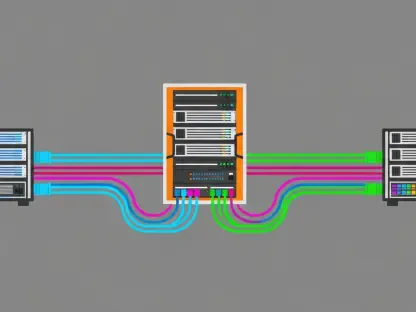The evolution of artificial intelligence (AI) technology has revolutionized various industries, opening up new possibilities and efficiencies. However, this technological leap also brings significant risks. While AI offers many potential benefits, it concurrently enables malicious actors to exploit these advancements for cyberattacks. This dual-edged nature of AI has created an urgent need for cybersecurity professionals who can anticipate and counteract these sophisticated threats. The demand for expertise in this field is surging, driven by the increasing complexity of cyber threats and the need to protect sensitive information across various sectors.
The Impact of AI on Cybersecurity
AI as a Double-Edged Sword
One of the most significant impacts of AI on cybersecurity is its ability to be both an asset and a vulnerability. Since the introduction of ChatGPT over two years ago, AI has brought incredible advancements, but it has also facilitated new avenues for cyberattacks. The widespread accessibility of AI tools means that both positive and negative uses of AI are expanding rapidly. Chris Schueler, CEO of Cyderes, emphasizes that any technological advancement inevitably attracts those who seek to misuse it, and AI is no exception. By providing cybercriminals with the same powerful tools used for beneficial purposes, AI levels the playing field, making it easier for them to launch complex and damaging cyberattacks.
As AI technology continues to develop, it becomes increasingly challenging to differentiate between legitimate and malicious applications. The same algorithms that predict consumer behavior can be used to simulate user activities and bypass security protocols. The dual-use nature of AI complicates cybersecurity efforts, as professionals must develop defenses against threats that are not only more sophisticated but also rapidly evolving. The dynamic nature of AI-driven attacks necessitates a proactive approach, where cybersecurity experts must constantly innovate and adapt to stay ahead of ever-changing threats.
Sophistication of Cybercriminal Activities
The sophistication of cybercriminal activities has significantly increased with the integration of AI technologies. Cybersecurity professionals face the daunting task of staying one step ahead of these advanced threats. Chris Risley, CEO of wireless threat intelligence company Bastille, highlights that malicious actors are becoming more adept at utilizing AI to enhance their capabilities. This enhanced skill set of cybercriminals underscores the necessity for robust cybersecurity measures and highly skilled professionals who can effectively counter such sophisticated attacks.
AI enables cybercriminals to automate and scale their operations, making it easier to perform large-scale attacks with minimal effort. For instance, AI can be used to automatically generate phishing emails tailored to specific individuals, increasing the likelihood of successful breaches. The use of machine learning algorithms allows attackers to analyze vast amounts of data quickly, identifying vulnerabilities and devising more effective strategies. As a result, cybersecurity experts must continuously update their knowledge and skills to keep up with the evolving threat landscape. The constantly changing nature of cyber threats means that what worked yesterday may not be effective today, making adaptability a crucial trait for cybersecurity professionals.
Rising Demand for Cybersecurity Talent
Projected Growth in Cybersecurity Jobs
The changing threat landscape, driven by AI advancements, has significantly heightened the demand for cybersecurity talent. This growing need is a critical concern for both companies and governments aiming to protect themselves against AI-driven cyber threats. According to the US Bureau of Labor Statistics, the number of information security analysts is projected to grow by 33% between 2023 and 2033. This projection underscores the urgent requirement for specialized expertise in safeguarding computer systems against increasingly sophisticated cyber threats.
The surge in demand for cybersecurity professionals is not just a response to current threats but also a proactive measure to anticipate future challenges. Companies and governments are investing heavily in cybersecurity infrastructure and talent development to create a resilient defense framework. This proactive approach aims to prevent breaches and mitigate the impact of attacks quickly. As cyber threats become more complex and widespread, the role of cybersecurity experts will become increasingly vital in maintaining the integrity and security of digital environments. The projected growth in cybersecurity jobs reflects the critical need for skilled professionals who can navigate and combat the evolving threat landscape effectively.
Reasons Behind the Surge in Demand
Several factors contribute to the surge in demand for cybersecurity talent, particularly the sophisticated use of AI by malicious actors. Paul Caron from S-RM explains that attackers are now using AI to understand behavioral analytics, such as employees’ login patterns, making it easier to devise more effective attacks. This understanding allows cybercriminals to anticipate and exploit security vulnerabilities with greater precision. Danny Jenkins, CEO of ThreatLocker, highlights that AI has democratized the ability to create malicious software. This democratization has significantly lowered the skill threshold required to develop complex malware, increasing the number of potential threats exponentially.
The growing reliance on AI for various business operations also increases the attack surface, making organizations more vulnerable to cyberattacks. As companies integrate AI-driven technologies to improve efficiency and innovation, they must also invest in cybersecurity measures to protect these systems. The interconnected nature of modern digital infrastructures means that a breach in one area can have cascading effects across an entire organization. As a result, the need for cybersecurity experts who can anticipate and mitigate these risks is more critical than ever. Organizations must balance the benefits of AI with the necessity of robust cybersecurity to ensure the continued success and security of their operations.
Evolution of Cyber Threats
Advanced Phishing Scams and Deepfakes
The evolution of cyber threats has been marked by the increasing sophistication of traditional attack methods and the emergence of new, AI-driven tactics. Traditional phishing scams, once easily detectable by red flags such as spelling errors and poorly constructed messages, have become far more sophisticated. AI enables attackers to create highly convincing phishing emails that mimic legitimate communications, making it significantly harder for individuals to discern genuine messages from malicious ones. The sophistication of these attacks requires cybersecurity professionals to develop more advanced detection and prevention techniques to counteract them effectively.
Deepfakes represent another alarming trend in the evolution of cyber threats. AI technology allows criminals to create realistic videos that can convincingly simulate someone’s appearance and behavior within minutes. As Schueler notes, the ability to produce such convincing deepfakes poses significant risks, as they can be used for social engineering attacks, spreading misinformation, and damaging reputations. The rapid advancement of AI-driven deepfakes challenges traditional security measures, necessitating the development of new strategies and tools to identify and mitigate these threats. The increasing prevalence of AI-driven cyber threats highlights the need for continuous innovation and adaptation within the cybersecurity field.
Global Reach of Cyber Attacks
The digital age has effectively removed geographical barriers for cybercriminals, enabling them to launch attacks from anywhere in the world. This global reach has dismantled many of the natural protections and perimeters that companies once relied on for security. Mike Britton of Abnormal Security explains that attackers no longer need physical access to a building or network to compromise it. The ability to strike remotely has significantly expanded the potential attack surface, making it more challenging for organizations to defend against breaches. Cybersecurity professionals must adopt a global perspective and implement comprehensive security measures to protect against distributed and sophisticated cyber threats.
The interconnected nature of modern digital ecosystems further complicates the cybersecurity landscape. A breach in one part of the network can have far-reaching implications, affecting multiple systems and organizations. The global reach of cyber attacks means that cybersecurity incidents can disrupt operations across borders, highlighting the need for international cooperation and shared best practices in cybersecurity. As cyber threats continue to evolve, the role of cybersecurity professionals will become increasingly critical in maintaining the integrity and security of digital infrastructures on a global scale. The ability to anticipate and respond to threats from any corner of the world will be a key factor in the success of cybersecurity efforts.
Challenges in Meeting the Demand
Cybersecurity Workforce Gap
The cybersecurity workforce gap is a significant challenge facing the industry, with an estimated 4.8 million unfilled jobs globally, according to a 2024 study from ISC2. This gap represents a 19% year-over-year increase, underscoring the urgency of addressing this issue. The increasing sophistication of cyber threats has made the job more challenging, requiring professionals to constantly update their skills and knowledge. The gap in the cybersecurity workforce is not just a matter of numbers but also of expertise, as the complexity of cyber threats demands highly specialized skills to counteract them effectively.
Filling the cybersecurity workforce gap is a critical priority for organizations worldwide. Cybersecurity roles take, on average, 21% longer to fill than other IT jobs, according to data from Cyberseek. This extended time to hire indicates the high demand for skilled professionals and the shortage of candidates with the necessary expertise. To address this gap, organizations must invest in education and training programs to develop the next generation of cybersecurity experts. Additionally, efforts to encourage diversity and inclusion within the field can help tap into a broader talent pool, bringing new perspectives and solutions to the complex challenges facing the cybersecurity industry.
Complexity of the Job
The complexity of cybersecurity roles has grown significantly, necessitating an ever-increasing number of protocols and policies to manage. MK Palmore from Google Cloud notes that many cybersecurity professionals began their careers in IT and transitioned into the field, highlighting the difficulty for new candidates to gain the necessary hands-on experience. The rapid pace at which cyberattacks evolve makes it challenging for professionals to stay current. Even a short break in employment could result in a significant knowledge gap, underscoring the need for continuous learning and professional development within the field.
Cybersecurity professionals must navigate a complex landscape of ever-changing threats, regulations, and technologies. The job requires a deep understanding of various systems, networks, and potential vulnerabilities. As the digital environment becomes more intricate, professionals are tasked with managing a broader range of responsibilities, from threat detection and response to policy development and compliance. This complexity necessitates a multidisciplinary approach, combining technical expertise with strategic thinking to effectively safeguard against cyber threats. The continuous evolution of the cybersecurity landscape demands that professionals remain adaptable and proactive, constantly updating their skills to address emerging challenges.
High Stakes and Notable Incidents
Critical Role of Cybersecurity Systems
The stakes in cybersecurity are incredibly high, as evidenced by notable incidents that have had far-reaching consequences. One such incident involved DNA-testing company 23andMe, which faced a $30 million lawsuit settlement after hackers accessed millions of customers’ personal data. This breach highlights the critical importance of robust cybersecurity systems in protecting sensitive information and maintaining customer trust. Another significant incident was the global IT outage caused by a software issue at cybersecurity firm CrowdStrike. Despite not being the result of a breach, this outage disrupted numerous industries, demonstrating the vital role cybersecurity systems play in maintaining the functionality of essential technologies.
These incidents underscore the importance of having highly skilled cybersecurity professionals who can anticipate and prevent potential threats. The ability to respond quickly and effectively to breaches is crucial in minimizing the impact on affected organizations and individuals. As cyber threats become more sophisticated and pervasive, the role of cybersecurity experts becomes increasingly critical in safeguarding the digital infrastructure that underpins modern society. The high stakes involved in cybersecurity highlight the need for continuous investment in talent, technology, and training to ensure that defenses remain robust and effective against evolving threats.
Training and Development Challenges
While larger companies like Cyderes and S-RM can offer specialized training programs, smaller firms often lack the resources to provide such development opportunities. This discrepancy can create a talent gap, as smaller companies may struggle to attract and retain experienced cybersecurity professionals. Chris Risley mentions that his company prefers hiring experienced professionals over recent graduates due to the advanced skills required. This preference reflects the need for immediate expertise in managing complex cybersecurity challenges, as new graduates may require extensive training before they can contribute effectively.
Addressing the training and development challenges within the cybersecurity field requires a collaborative effort from industry, academia, and policymakers. Creating pathways for hands-on experience, internships, and continuous education can help bridge the gap between entry-level positions and advanced expertise. Additionally, partnerships between larger firms and smaller companies can facilitate knowledge transfer and provide valuable training resources. By investing in the development of cybersecurity talent, organizations can build a more resilient workforce capable of addressing the increasingly sophisticated threats posed by AI and other advanced technologies.
Promising Opportunities in Cybersecurity
Lucrative Career Prospects
The evolution of artificial intelligence (AI) technology has transformed many industries, bringing new opportunities and efficiencies. However, this advancement also introduces considerable risks. While AI presents numerous potential benefits, it simultaneously allows hackers to leverage these innovations for cyberattacks. This dual-edged nature of AI has led to a pressing demand for cybersecurity professionals capable of predicting and mitigating these advanced threats. As cyber threats grow increasingly complex, the need to protect sensitive information in various sectors has become more critical than ever. Consequently, the surge in demand for expertise in this field reflects the urgency of developing robust cybersecurity measures to safeguard against potential breaches. Training initiatives and educational programs specializing in cybersecurity are becoming essential to equip professionals with the skills needed to navigate this challenging landscape. The intersection of AI and cybersecurity represents both a challenge and an opportunity, emphasizing the importance of staying ahead in the ever-evolving digital age.









